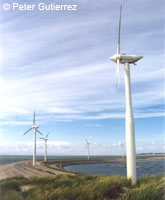Europe leads world on wind power
Global wind electricity-generating capacity increased by 24 per cent in 2005 to a total of 59,100 megawatts, according to figures released by the Earth Policy Institute (EPI). Leading this global surge in wind energy use is Europe, with over 40,500 megawatts of installed capacity, around two thirds of the global total and enough to meet the needs of over 40 million people. With an average annual growth rate of 29 per cent over the last ten years, wind is the fastest growing energy source, ahead of solar photovoltaics (26 per cent) and far ahead of fossil fuels like coal, which is growing at a rate of 2.5 per cent a year. Wind energy supplies three per cent of Europe's electricity, a figure which the European Wind Energy Association (EWEA) hopes will rise to 23 per cent by 2030. The country closest to achieving this goal is Denmark, which already gets 20 per cent of its electricity from wind power, and is the global leader in offshore wind power installations. According to the EWEA, Europe has enough wind resources to meet the electricity demands of all its countries. Elsewhere in the world, the on-off availability of the Wind Production Tax Credit (PTC) meant growth in the US was erratic for a number of years. However, the recent extension of the PTC for two years means the American wind energy industry is planning on installing 25 per cent more capacity in 2006 than in 2005. India is currently the leading Asian country for wind power, and with 4,400 megawatts of capacity is ranked fourth in the world after Germany, the US and Spain. In China, the new Renewable Energy Law provides tax incentives and subsidies for wind power, with the aim of creating 30,000 megawatts of wind capacity by 2010. Current production in the country stands at 1,260 megawatts. According to the EPI, the main reason for the expansion of world wind power is its increasing technological sophistication. Modern turbines are taller and have longer rotor blades than those of 20 years ago, allowing them to produce up to 200 times more power. Improvements in technology have also helped to bring down the cost of wind power, from €0.30 per kilowatt-hour in the mid-1980s to just €0.03 now in the best wind sites. Other factors in the price reduction are economies of scale in the production of wind turbine components and declines in the cost of financing wind projects. Furthermore, 48 countries have put in place laws and regulations to promote the growth of renewable energy sources. The EPI points out that if environmental, social and other costs were accounted for in the costs of electricity, wind energy would in fact be cheaper than energy derived from fossil fuels. Furthermore, wind energy offers long term energy security. The figures were collated by the EPI as part of its 'Eco-Economy Indicators' series, which the EPI uses to track major trends that are affecting progress toward an eco-economy.



